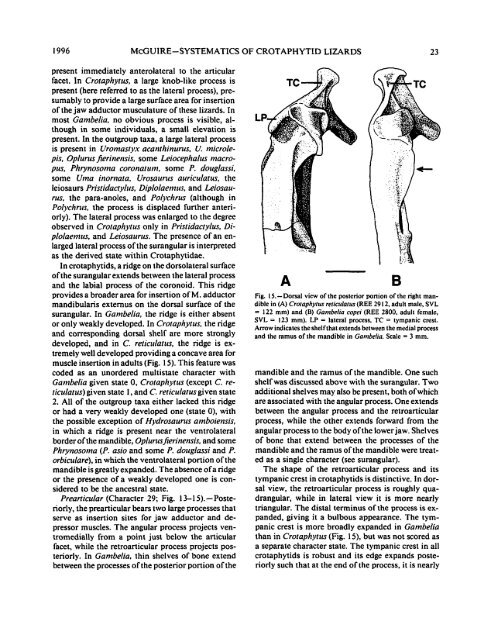Download Full Document - Mountain Boomer Music!
Download Full Document - Mountain Boomer Music!
Download Full Document - Mountain Boomer Music!
You also want an ePaper? Increase the reach of your titles
YUMPU automatically turns print PDFs into web optimized ePapers that Google loves.
1996 McGUIRE-SYSTEMATICS OF CROTAPHYTID LIZARDS 23<br />
present immediately anterolateral to the articular<br />
facet. In Crotaphytus, a large knob-like process is<br />
present (here referred to as the lateral process), pre-<br />
sumably to provide a large surface area for insertion<br />
of the jaw adductor musculature of these lizards. In<br />
most Gambelia, no obvious process is visible, al-<br />
though in some individuals, a small elevation is<br />
present. In the outgroup taxa, a large lateral process<br />
is present in Uromastyx acanthinurus. U. microle-<br />
pis, Oplurus fierinensis, some LRiocephalus macro-<br />
pus, Phrynosoma coronatuni, some P. douglassi.<br />
some Uma inornata. Urosaurus auriculatus, the<br />
leiosaurs Pristidactyltcs, Diplolaenttrs, and Leiosau-<br />
rus, the para-anoles, and Polychrus (although in<br />
Polychnts, the process is displaced further anteri-<br />
orly). The lateral process was enlarged to the degree<br />
observed in Crotaphytus only in Pristidactylus. Di-<br />
plolaemus, and Leiosaurus. The presence of an en-<br />
larged lateral process of the surangular is interpreted<br />
as the derived state within Crotaphytidae.<br />
In crotaphytids, a ridge on the dorsolateral surface<br />
ofthe surangular extends between the lateral process<br />
and the labial process of the coronoid. This ridge<br />
provides a broader area for insertion of M. adductor<br />
mandibularis externus on the dorsal surface of the<br />
surangular. In Gambelia, the ridge is either absent<br />
or only weakly developed. In Crotaphytus, the ridge<br />
and corresponding dorsal shelf are more strongly<br />
developed, and in C. rericttlatus, the ridge is ex-<br />
tremely well developed providing a concave area for<br />
muscle insertion in adults (Fig. 15). This feature was<br />
coded as an unordered multistate character with<br />
Gambelia given state 0, Crotaphytus (except C. re-<br />
riculatus) given state 1, and C. reticulatus given state<br />
2. All of the outgoup taxa either lacked this ridge<br />
or had a very weakly developed one (state 0), with<br />
the possible exception of Hydrosaurus amboiensis,<br />
in which a ridge is present near the ventrolateral<br />
border of the mandible, Oplurusfierinensis, and some<br />
Phrynosorna (P. asio and some P. douglassi and P.<br />
orbiculare), in which the ventrolateral portion of the<br />
mandible is greatly expanded. The absence of a ridge<br />
or the presence of a weakly developed one is con-<br />
sidered to be the ancestral state.<br />
Prearticular (Character 29; Fig. 13-1 5). - Poste-<br />
riorly, the prearticular bears two large processes that<br />
serve as insertion sites for jaw adductor and de-<br />
pressor muscles. The angular process projects ven-<br />
tromedially from a point just below the articular<br />
facet, while the retroarticular process projects pos-<br />
teriorly. In Gambelia, thin shelves of bone extend<br />
between the processes of the posterior portion of the<br />
Fig. 15.- Dorsal view of the posterior portion of the right man-<br />
dible in (A) Croraphyrus relicularus (REE 29 12, adult male, SVL<br />
= 122 mm) and (B) Gambelia copei (REE 2800, adult female,<br />
SVL = 123 mm). LP = lateral process, TC - tympanic crest.<br />
Arrow indicates the shelfthat extends between the medial process<br />
and the ramus of the mandible in Gambelia. Scale = 3 mm.<br />
mandible and the ramus of the mandible. One such<br />
shelf was discussed above with the surangular. Two<br />
additional shelves may also be present, both of which<br />
are associated with the angular process. One extends<br />
between the angular process and the retroarticular<br />
process, while the other extends forward from the<br />
angular process to the body ofthe lower jaw. Shelves<br />
of bone that extend between the processes of the<br />
mandible and the ramus of the mandible were treat-<br />
ed as a single character (see surangular).<br />
The shape of the retroarticular process and its<br />
tympanic crest in crotaphytids is distinctive. In dor-<br />
sal view, the retroarticular process is roughly qua-<br />
drangular, while in lateral view it is more nearly<br />
triangular. The distal terminus of the process is ex-<br />
panded, giving it a bulbous appearance. The tym-<br />
panic crest is more broadly expanded in Gambelia<br />
than in Crotaphytus (Fig. 15), but was not scored as<br />
a separate character state. The tympanic crest in all<br />
crotaphytids is robust and its edge expands poste-<br />
riorly such that at the end of the process, it is nearly


